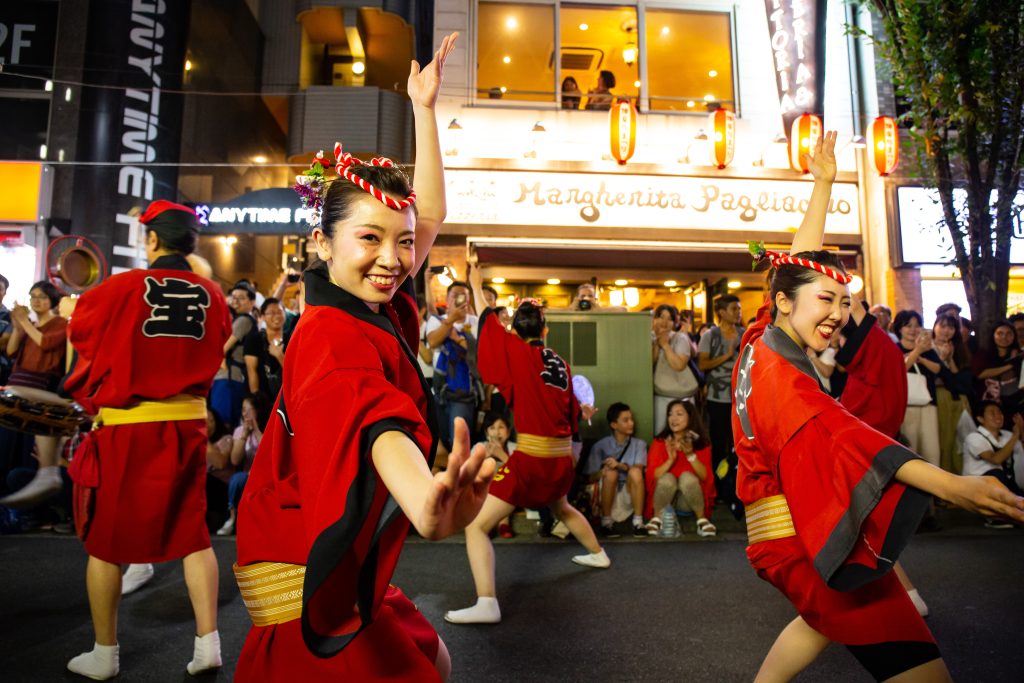
Have you ever heard of “Awaodori”? This traditional dance’s name is made of two words “Awa” (Tokushima prefecture’s former name) and “odori” (dance). It’s sometimes called “Dance of Fools” and is usually celebrated during “Obon” (Festival of the Dead) in Japan, which generally takes place in July and August every year.
[getpage file=”wordpress-shortcode/whitepaper-modal.html”]
Awaodori: The origins of a traditional Japanese dance
As you may have guessed, this traditional dance comes from Tokushima prefecture, located on Shikoku Island in Japan. Beyond a simple dance, it embodies many cultural, historical and artistic aspects of Japan. Even though the origins of Awaodori can be traced back to the Kamakura period (1185 – 1333), one of its possible birth dates back to 1587, when the daimyo (feudal lord) of the Awa province decided to hold a party for the inauguration of Tokushima castle.
During this party, locals got drunk and started dancing and playing music, creating a simple rhythm and song that everyone could dance to and so was born the famous dance. However, there are other theories stating that the famous dance could also come from the Furyu dance or Bon-odori, though the Tokushima Castle one is the most famous.
Awaodori song’s lyrics
Traditionally, there are two types of dance: Nagashi during the day and Zomeiki at night. Zomeiki is the most famous one as it gets more eccentric than the day-time one. If you attend an Awaodori Matsuri, you will usually hear the traditional chant “Awa Yoshikono” which consists of the following lyrics:
- 踊る阿呆に (Odoru ahō ni) The dancers are fools
- 見る阿呆 (Miru ahō) The watchers are fools
- 同じ阿呆なら (Onaji ahō nara) Both are fools alike so
- 踊らな損、損 (Odorana son, son) Why not dance?
Dancers will also shout words such as “Eraiyaccha, eraiyaccha” or “yattosa, yattosa”, also called hayashi kotoba or kakegoe. Moreover, men and women have to dance according to a different pattern, unless they are teenagers and usually follow the men’s dance. Women will wear a yukata with a amigasa (braided hat) while men will wear a happi, a Japanese coat worn during festivals.
During the festival, the parade is divided into “ren” which are groups of dancers that can range from amateurs to professional. Each ren dances to a different rhythm making the parade quite entertaining to watch.
SNG students can experience Awaodori too
Nowadays, Awaodori is celebrated all over Japan, even in Tokyo! With SNG students we usually attend at least one Awaodori event over summer. Since the latter never goes without a Matsuri, it’s always nice to dress up with a yukata, get some snacks and drinks and enjoy the show!
Awaodori in Kagurazaka, Tokyo
In Kagurazaka, the notorious dance is part of the “Kagurazaka Matsuri” (Kagurazaka Festival) that lasts four days. The first two days are dedicated to a Hozuki market (winter cherry seeds) and the two last ones are usually restricted to Awaodori.
Awaodori in Shimokitazawa, Tokyo
Shimokitazawa offers a festival exclusively dedicated to Awadori. It lasts for two days and people passing by can enjoy the show watching 12 to 13 Awaodori teams!
